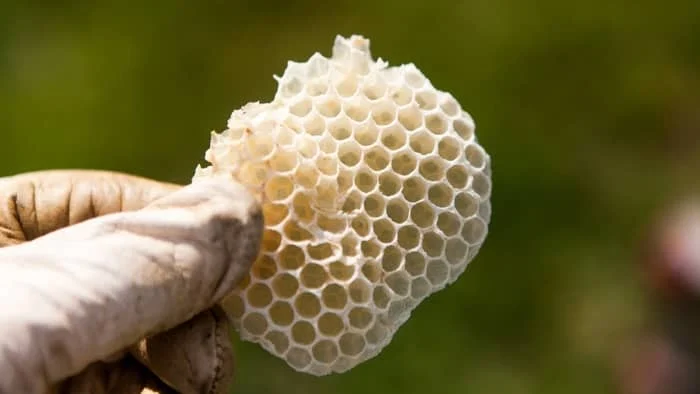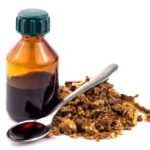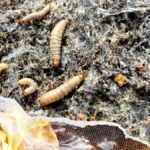In this article, we take a look at what are bees nests made of – or more specifically, what beehives are made of. Bees are master builders, and you will be surprised to know it is not just wax that forms an integral part of the structure of the hive.
What Are Bees Nests Made Of?
A bee nest or beehive is that area where bees live. In this hive, they need to process pollen and nectar into food for themselves and the hives brood nest. They need to store honey, and they need to be able to close holes, expand sections and build infrastructure to allow them to function.
In this regard, bees use honeycombs for most of the infrastructural functions, and propolis for certain other functions. Bees are, to a limited extent, capable of expanding their hive as well. We will look into this in more depth after we review the three primary hive components – beeswax, bee silk and propolis.
Bee Hives of Beeswax
Beeswax is an amazing mixture of organic compounds which melts at 144 to 147 °F. When arranged in the hexagonal shape of a honeycomb the engineering strength of this material is quite amazing. Beeswax can hold a huge volume of heavy honey with a very small percentage of structural material. In this way, a beehive can store hundreds of pounds of honey in some cases.
Beeswax is made by the bees mixing two different secretions. Wax scales are secreted at points in the abdomen and mixed with mandibular secretions. The mixture reacts and hardens into beeswax. Young bees that are recently emerged from the brood are the main wax producers. They consume copious amounts of honey. These bees then hang in festoons secreting wax and building this into honeycombs.
In order to make wax, bees require a bit of heat, so generally, a strong hive that produces abundant heat will build a lot of wax. Significant quantities of honey are required to produce a unit of wax. Estimates vary from 5 to 15 weight units of honey to produce one unit of wax.
Once the beeswax is formed into the hexagonal honeycomb shape, it is relatively strong. However, the bees can strengthen this further.

Learn more about: Bee Foundation Plastic vs Wax
Bee Hives Made with Bee Silk
Every time a bee metamorphosizes in a honeycomb cell, it leaves behind a very small layer of bee silk. This makes the comb take on a dark colour, and over time, dark brood comb cells form. These cells consist of a composite material a bit like fibreglass. It is a mixture of bee silk and beeswax.
Brood combs are extremely strong. I once remember seeing a beekeeper dare another beekeeper to slap him in the face with a brood comb from a wild beehive. Mead was involved. The result was a broken nose. If that had been a honeycomb he would just have looked sticky and laughed. The brood comb is strong.
There was a research group in China that developed a method to actually use bee silk and made ladies underwear from it. A quick search of the internet does not yield any proof that this ever made it to market sadly.
Propolis for Bee Hives
Propolis is a mixture of plant resins collected from nature and a bit of beeswax, organic matter such as plant fibres, leaves, grass and so on. It can also contain insects, beetles, dung, rocks, sweet wrappers, skeletons and other things. We will go into that in a bit more detail shortly.
Whenever a plant is injured, it has to close the injury with a scab to prevent bacteria, fungi, viruses, insects and pathogens from entering the plant. In many cases, an injured plant will also produce bitter compounds and poisons to chase herbivores away.
Bees collect this resin from plants. They return to the hive and mix the resin, together with recycled wax from the hive. Sometimes they will combine this with fibre and other solid material to make a composite material which we call propolis.
Propolis is a Greek word – Pro means in front of, and polis means city. So it was the stuff in front of the city. Ancient Greeks viewed beehives correctly as cities. In beehives, there is a layer of propolis that is normally placed in front of the hive to protect it.
Other Things In Propolis
Bees are master builders. They will often incorporate other materials into propolis to make it stronger. I have seen bees incorporate small pieces of grass fibre. They will also sometimes incorporate random things they find in the hive into propolis for bulking. Snail shells, rat skeletons, millipedes, goat droppings, pieces of wood, and even sweet wrappers are found in propolis.
Propolis As A Paint
Over time a hive builds up strength and protection of the hive. They will paint the surface of the inside of the hive with propolis. This makes the hive waterproof and closes holes that ants and other pests can enter the hive through.
In-ground hives the bees will actually stick earth together with propolis – they then build combs from this strengthened surface and when the combs reach the base of the cavity, attach the combs to the floor. These earth nest beehives can survive for decades underground in the central drier areas of Africa.
I have helped to excavate such hives and we harvested many pounds of propolis from individual hives. These hives were excavated for research purposes to study the dimensions of wild beehives.
With time, bees will also paint combs with a slight layer of propolis. This helps to strengthen the combs. It also means if you extract wax from old combs that you get a lovely aromatic chocolate brown wax. Propolis is actually medicinal.
How Do Bees Make Beehives In The Wild?
Long before beekeepers, bees were pretty good at making their own hives in places they choose. Typically a swarm scouts out a nesting site during a honey flow. They move into the site and immediately start working. The first thing to do is to build some combs. The queen starts laying eggs in these.
At the same time, other bees will clean the nesting site out. They will carry loose debris away – leaves, feathers and insects. If they happened to move into a place that had other things living in it – such as small animals or birds, these are stung to death and covered in propolis. I have often found birds, rats, mongeese and other things that were unfortunate enough to be in a hole that was occupied by a swarm. These will be mummified in propolis.
If the bees have nested in a tree with rotted wood, they will often enlarge the hive by chewing this wood and removing it.
Propolising Entrances
Once the hive becomes established and has a big enough workforce, they will begin gathering propolis. This is used to reduce the entrance size, cover the inside of the hive and build up defences.
I have seen hives on cliffs where the entire hive – sometimes more than two yards long and half a yard deep and a yard wide are covered in propolis. These monster cliff hives can be ancient. In many cases, a layer of propolis half an inch thick covers the hive. Do not venture near such a hive on a warm day for fear of being heavily stung.
In man-made beehives, the bees will reduce the size of the entrance holes as they see fit using propolis.
We hope this article has helped you understand what bees make their hives out of. Bees are amazing creatures and the ancient Greeks were wise in calling beehives cities. We hope this article has helped you understand some more of the magic our little friends bring to this world – bees are amazing – share widely.
Read more about: What Is The Difference Between Raw Honey and Pure Honey?
Bee Nest Materials FAQs
How do bees make beeswax for their nests?
Bees make beeswax by secreting wax scales from their abdomens and mixing it with secretions from their mandibles. This wax is then used to build honeycomb.
What is bee silk, and how is it used in the hive?
Bee silk is a protein left behind in brood cells after a bee matures. Over time, it strengthens the comb, making it more durable and darker.
What is propolis, and why do bees use it?
Propolis is a resinous material collected from plants and mixed with beeswax. Bees use it to seal gaps, strengthen the hive, and protect against pathogens.
Do bees only use beeswax and propolis to build their hives?
No, bees also use materials like fibers, leaves, and even debris like insect shells and sweet wrappers, incorporating them into propolis for added strength.
How do bees reinforce the inside of their hives?
Bees “paint” the interior surfaces of their hive with propolis, creating a waterproof, protective layer that also helps prevent pests from entering.
Can bees make hives without human intervention?
Yes, wild bees have been building hives for millions of years. They choose nesting sites, clean them out, and use wax and propolis to create and protect their hives.
What other things can be found in propolis?
Propolis can contain plant fibers, small animal skeletons, insect shells, and even random objects like snail shells or plastic bits from human debris.
How do bees make the hive entrance smaller?
Bees use propolis to reduce the size of hive entrances, especially when they need to defend against predators or pests.
What happens to creatures that bees find in their chosen nesting site?
If bees find creatures like birds or rodents in their nest site, they sting them to death and mummify the bodies with propolis to prevent decay.
Why are some wild beehives covered entirely in propolis?
In some cases, bees coat their hives, especially large ones on cliffs, with thick layers of propolis for protection, which can make the hive last for many years.

Dr. Garth A. Cambray is a Canadian/South African entrepreneur and beekeeper with 28 years of experience in apiculture and specializes in adding value to honey. His Ph.D. research developed a new advanced continuous fermentation method for making mead that has resulted in a number of companies globally being able to access markets for mead. His company, Makana Meadery, exports honey mead to the USA where it is available to discerning connoisseurs. He has also developed technologies to commercially manufacture organic honey vinegar in Zambia for export globally. He holds a few patents globally in the ethanol industry and believes in technology and knowledge transfer for human development and environmental sustainability. One of his proudest achievements is the fact that the wind farm he started at one of his old apiary sites has essentially made his hometown carbon neutral.






